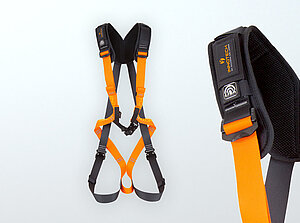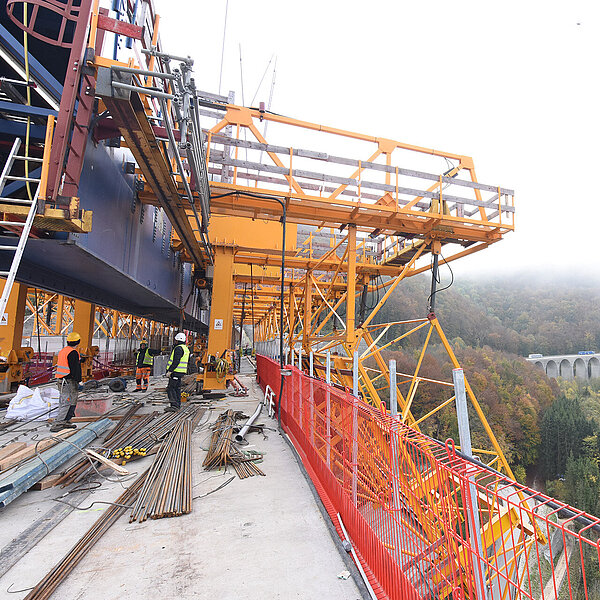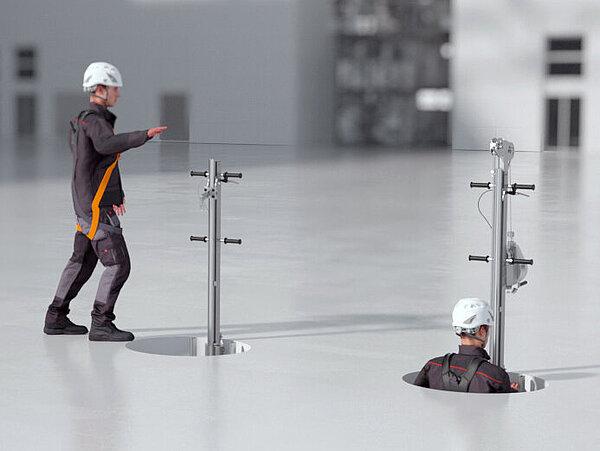The six sections of the Construction Workers Protection Regulation cover general and specific requirements and measures, inspection and maintenance, implementation of employee protection and legal obligations, official measures and, last of all, final and transitional provisions.
A contractor on a construction site is legally obliged to ensure the safety of the employees, and must therefore be informed about the contents of the BauV. In this blog post we go in particular into the contents relating to protection of people from falling.
Personal protective equipment as a general requirement, and measures on the construction site
The general requirements and measures deal with topics like supervision, control and reporting of construction tasks, personal protective equipment, and also first aid on the construction site. In combination with fall protection, personal protective equipment is logically a relevant point as a measure for individual protection.
For working safely on the construction site, it is necessary that the people employed there are “suitable” for such work, both physically and mentally. This also includes them having the corresponding specialist knowledge, such as how to don and use personal protective equipment. This knowledge is obtained through specialist training.

Personal Protective Equipment PPE
Whether on roofs, scaffolding, ladders, facades, or other fall-risk areas, compliant high-quality equipment for fall protection is an absolute must.
Secure connection between user and safety system
Our PPE personal protective equipment creates a secure connection between user and fall protection systems. Depending on application and situation, it provides optimum comfort, and impresses through its top quality.

PPE STRING
PERSONAL PROTECTIVE EQUIPMENT PPE
Intuitive use, optimum comfort, top quality: Just some of the characteristics of our anti-fall harness systems. The PPE STRING harness system is available in Basic, Comfort, and Pro models. All harnesses allow optimum freedom of movement and ...

PPE LANYARDS
PERSONAL PROTECTIVE EQUIPMENT PPE
PPE LANYARDS are the secure connection to INNOTECH anchor points. There are a number of variations which fulfil the respective requirements in terms of operation and loading.
A distinction is made between construction site activities and mining activities performed in the course of seeking, extracting, and preparing mineral raw materials. However, if construction work is performed during mining activities, then the BauV applies.
Protection of workplaces and traffic routes by means of coverings and peripheral guards
As also in the German regulation on fall protection, ASR A2.1, the protection of workplaces AND traffic routes is also a component of the Austrian Construction Workers Protection Regulation. Because they are occupied only for a short time, traffic routes in particular run the risk of being overlooked, and a certain illusion of safety therefore exists.
However, a fall risk arises even in danger areas which are traversed only briefly, for the purpose of accessing the actual workplace. For the protection of workplaces and traffic routes, the BauV provides for fall protection systems, barriers, and protective equipment.
- The BauV defines “coverings of openings and cavities” as suitable fall protection, as long as these coverings are load-bearing and cannot be moved.
- Guardrails – or “peripheral guards” in the technical jargon – at the various fall edges are also measures defined within the BauV as fall protection systems.

Skylight Protection System LIGHT
Skylights or strip lights are often installed to allow sufficient light to penetrate areas beneath flat roofs.
The protection system for skylights and strip lights
With the LIGHT skylight protection system, Innotech provides simple and effective safety without impairing the light penetration.

Guardrail System BARRIER
The variable railing system. As collective protection, the BARRIER guardrail system eliminates the danger which results from an edge.
The variable railing system
When accessing areas at height, edges (such as roof edges, working platforms, etc.) represent a danger area. One option for securing this danger area, both for construction work and for later servicing and maintenance tasks, consists of installing a guardrail system.
Barriers as an alternative fall protection solution
The Austrian Construction Workers Protection Regulation provides for a specific solution to protect against falls from balconies and loggias: Here, instead of fall protection systems, so-called barriers may also be installed. Barriers included, for example:
- Wooden parapets
- Metal pipes
- Tensioned cables
- Chains
Barriers can also be set up at a 2 metre distance from the fall edge. However, the “area between barrier and fall edge” must be accessed only if “this is necessary for work-related reasons. In this case, suitable personal protective equipment must be used to protect the employees against falling.”
When barriers are used it is necessary to wear PPE.
As is now perhaps evident, barriers are not the first choice, compared with permanent fall protection systems. Because wearing personal protective equipment (PPE) is a mandatory legal requirement when accessing the fall risk area – and in any case is safer as a rule – the installation of barriers may require greater time and effort than implementing a reliable fall protection system. (Apart from this, a barrier is permitted “only for surfaces with an inclination up to 20°.”)
What if neither a fall protection system nor a barrier can be implemented?
In certain cases the construction site circumstances may be so problematic that neither fall protection systems nor barriers can be installed. In such a case, as per the Construction Workers Protection Regulation, so-called protective equipment must be implemented.
This protective equipment includes the generally familiar safety nets, like those used for numerous roofing tasks and visible to the general public. The Austrian BauV thus permits these measures for protective equipment:
- Catch scaffolds
- Safety nets
- Roof catch scaffolds
- Roof protection boards
Safety cables and harnesses do not come under the definition of protective equipment. In this context the wiki post Restraint and fall arrest systems may also be of interest.
The employer’s obligations as per BauV
On the construction site the employer, i.e. the contractor, is responsible for compliance with all requirements and measures arising from the Construction Workers Protection Regulation. Depending on the location and type of the construction site, various directives and provisions apply; these can be consulted in detail in the BauV.
The commented version of the BauV is available on the Austrian Labour Inspectorate website. This provides a clear, interactive table of contents from which a single click takes you to the required content. In addition, the comments clarify details of the text.
The employee too is obliged to comply with the respective regulations when performing his tasks, and to follow instructions given. Ultimately, it is a matter of protecting one’s own life and limb.







